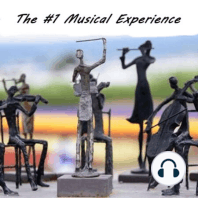97 min listen

Antonio Rossini ~The Barber of Seville - Act I (First Part)
Antonio Rossini ~The Barber of Seville - Act I (First Part)
ratings:
Length:
26 minutes
Released:
Jan 4, 2022
Format:
Podcast episode
Description
Gioachino Antonio Rossini was Born 29 February 1792, Died 13 November 1868, was an Italian composer who gained fame for his 39 operas. He also wrote many songs, some chamber music , piano pieces, and some sacred music. He set new standards for both comic and serious opera before retiring from large-scale composition while still in his thirties, at the height of his popularity. Born in Pesaro to parents who were both musicians. His father was a trumpeter and his mother a singer. Rossini began to compose by the age of 12 and was educated at music school in Bologna. His first opera was performed in Venice in 1810 when he was 18 years old. In 1815 he was engaged to write operas and manage theatres in Naples. In the period 1810–1823 he wrote 34 operas for the Italian stage that were performed in Venice, Milan, Ferrara, Naples and elsewhere. His productivity necessitated an almost formulaic approach for some components , such as overtures and a certain amount of self-borrowing. During this period he produced his most popular works, including the comic operas L'italiana in Algeri, Il barbiere di Siviglia (known in English as The Barber of Seville) and La Cenerentola. His works of this period brought to a peak the opera buffa tradition he inherited from masters such as Domenico Cimarosa and Giovanni Paisiello. He also composed opera seria works such as Otello, Tancredi and Semiramide. All of these attracted admiration for their innovation in melody, harmonic and instrumental colour, and dramatic form. In 1824 he was contracted by the Opéra in Paris, for which he produced an opera to celebrate the coronation of Charles X, Il viaggio a Reims , later cannibalised for his first opera in French, Le comte Ory. Revisions of two of his Italian operas, Le siège de Corinthe and Moïse, and in 1829 his last opera, Guillaume Tell. Rossini's withdrawal from opera for the last 40 years of his life has never been fully explained. Contributary factors may have been ill-health, the wealth his success had brought him, and the rise of spectacular grand opera under composers such as Giacomo Meyerbeer. . In the early 1830s to 1855, when he left Paris and was based in Bologna, Rossini wrote relatively little. On his return to Paris in 1855 he became renowned for his musical salons on Saturdays. Regularly attended by musicians and the artistic and fashionable circles of Paris. for which he wrote the entertaining pieces Péchés de vieillesse. Guests included Franz Liszt, Anton Rubinstein, Giuseppe Verdi, Meyerbeer and Joseph Joachim. Rossini's last major composition was his Petite messe solennelle (1863). He died in Paris in 1868. Get bonus content on Patreon Hosted on Acast. See acast.com/privacy for more information.
Released:
Jan 4, 2022
Format:
Podcast episode
Titles in the series (100)
Baroque Music for All Ages: Why We Should Expose Our Kids To Classical Music https://ourtownlive.net #herbw79The term "baroque" is generally used by music historians to describe a broad range of styles from a wide geographic region, mostly in Europe, composed over a period of... by The #1 Musical Experience